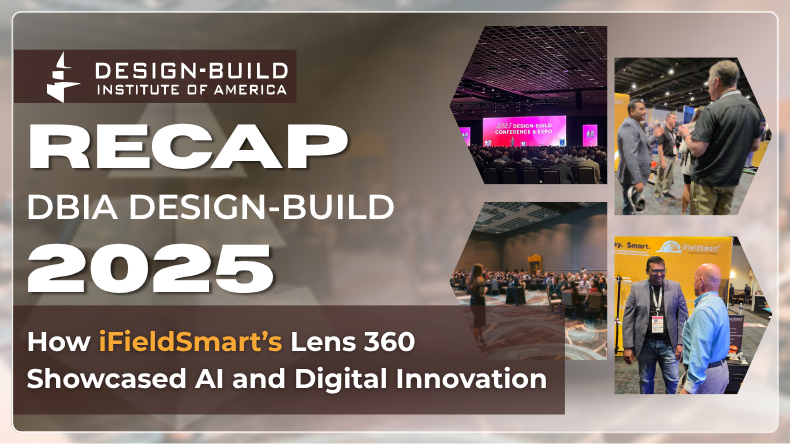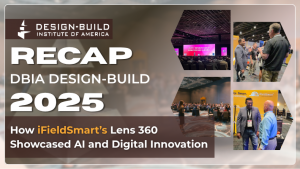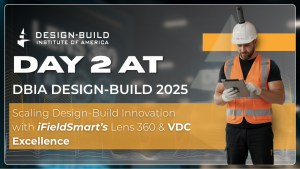Reading Time: 8 minutes
A Glimpse of Construction’s Future
The one word to define DBIA Design-Build 2025 is momentum. In every corner of the conference, the energy was clear: a united push to build smarter, faster, and with greater collaboration. This was not some industry meetup; it was a reality check and a reality upgrade. From AI-driven project insights to VDC excellence and Reality Capture breakthroughs, every conversation seemed to orbit one idea: how technology is reshaping Design-Build from the ground up.
And for us at iFieldSmart, being at Booth #431 was more than just showcasing tools; it was about being part of the conversation that’s steering the future of construction.
Setting the Stage: What Made DBIA 2025 Different
Construction conferences can sometimes feel like déjà vu. Same booths, same buzzwords, same big ideas.
Work Smarter, Not Harder
iFieldSmart empowers your team with AI-driven efficiency to simplify scheduling, boost collaboration, and keep projects on track.
Schedule a MeetingBut DBIA 2025 felt different.
This year’s theme was “Innovation Meets Integration”, wasn’t just printed on banners; it was embodied in every panel and demo.
- Collaboration is not a soft skill, but as a measurable project driver.
- AI wasn’t a futuristic concept; it is on screens, in workflows, and in conversations.
- Reality Capture moves from documentation to data-driven decision making.
From the first opening to the last networking session, the focus remained clear: the next generation of Design-Build is powered by data, collaboration, and trust.
Day 1: The Energy of Innovation
The first day kicked off like a spark. Session after session, the exploration continued of how VDC and AI are transitioning from theory to practical application. It wasn’t about “what’s possible someday”, it was about “what’s working now.”
Visitors stopped by Booth #431, curious about one question: “How can we use Reality Capture to bridge design and construction without slowing down the field?”
That’s where our demos hit home. With Lens360 by iFieldSmart, teams could visualize real project data in 360°, compare site conditions, and see how design intent translated into on-site execution, in real time. The conversations were about solving real pain points: schedule slippage, rework, and disconnected teams.
Day 2: Collaboration as the Core of Design-Build
By Day 2, the tone shifted from exploration to execution. The big takeaway?
Collaboration is not optional anymore; it’s operational.
The VDC panels highlighted how integrated modeling workflows are reshaping project delivery. People could feel the shift, owners, designers, and builders talking not in silos, but in a shared digital language.
And that’s where our conversations deepened. We talked with design managers, superintendents, and BIM coordinators about how data integration is not fancy dashboards; it leads to fewer RFIs, faster decisions, and happier owners.
Here’s the thing: True collaboration happens beyond the meeting room. It happens when teams trust their data. This is where the DBIA approach truly excels. When transparency takes the lead, Design-Build works.
Day 3: AI, Data, and the Future of Making Decision
Entering day 3, the energy was calming, a steady pace. Participants were listening and planning their next moves.
The AI sessions took center stage, showing how machine learning and predictive analytics are now integral for decision-making. Whether it was optimizing scheduling, predicting risks, or automating field verification, AI wasn’t being pitched as the next big thing; it was the thing.
For us, it validated what we’ve been building toward: a future where data does the heavy lifting and humans make smarter calls.
One keynote speaker said it best: “AI won’t replace the people who build — it will empower them to build better.”
It’s exactly the mindset that fuels our work at iFieldSmart: the technology should simplify the job and not complicate it.
What the Conversations Revealed at Booth #431
Throughout the three days, one message was clear: the industry is done with fragmented tools. They want a single source of truth, where design, field, and data converge.
And that’s the sweet spot where AI, VDC, and Reality Capture intersect.
Here’s what attendees consistently asked about:
- “Can we visualize and verify field progress in one platform?”
- “How can AI improve constructability reviews?”
- “Can digital twins really help us close the gap between design and delivery?”
The answer, we found, is not in more tools, but in smarter integration. When your data syncs between modeling, scheduling, and site capture, project confidence grows, and chaos shrinks.
Key Learnings from DBIA 2025
- Design-Build Done Right: Early collaboration changes everything. When the owners, designers, and builders align from the start, rework drops, and delivery becomes seamless. The result? Teams save time and money.
- AI in Construction: Forecasting insights provide project managers with the ability to foresee and prevent delays in project implementation, while delivering a project with a greater opportunity for success. The message was clear. AI doesn’t supplant human judgment; it amplifies it for better profitability and improved project outcomes.
- VDC Leadership: Visualization has become the language of alignment. Through data-driven models, teams can see what’s happening across design and construction. That clarity is replacing conflict with confidence.
- Reality Capture Evolution: Reality Capture has officially moved beyond documentation. It’s now a live feedback for digital decision-making, a way to verify progress, detect deviations, and maintain transparency across the project lifecycle.
- Ownership Models: Every successful Design-Build project starts with clear responsibility. The sessions emphasized that collaboration isn’t just about shared goals; it’s about defined roles. When ownership is clear, accountability and trust naturally follow.
Each of these lessons echoed throughout DBIA 2025, from owners curious about AI-driven scheduling to engineers discussing the “new normal” of integrated delivery.
A Few Standout Moments
- Watching a design team test Reality Capture workflows on the spot, and realizing how quickly data could resolve field queries.
- Seeing attendees’ eyes light up when they know about the AI and VDC can turn complex geometry into understandable visuals.
- Live AR/VR demos let teams step inside the project, seeing how everything fits before the final build.
- The RoboDog in action, scanning, walking, and collecting site data with precision, and showing how automation is reshaping field workflows.
- The conversations, over coffee or in hallway corners, where people admitted that their biggest challenge wasn’t tech, but trust.
Those were the real highlights. Because DBIA wasn’t just about the latest innovations; it was about restoring confidence in what’s possible when teams connect through data and intent.
The Human Side of Digital Transformation
Here’s something that stuck with us: Even the most advanced AI or VDC workflow can not replace one thing: human intelligence.
Behind every model, scan, and automation, there is a team making choices, asking questions, and solving problems that algorithms can’t see.
That’s why DBIA’s focus on people-first innovation resonated so deeply. Because at the end of the day, construction is still human work, digital tools make it more meaningful.
Our Takeaway as an Exhibitor
Standing on the other side of the booth gave us a front-row seat to the evolution of Design-Build.
Here’s what we walked away with:
- Collaboration isn’t optional — Success requires owners, designers, and builders aligned from day one
- Data integration defines outcomes — Real-time project data reduces errors and improves decisions
- VDC is the new foundation — 3D models are the shared language across all stakeholders
- AI augments human intelligence — Automation frees teams to focus on judgment, not busywork
- Reality capture provides truth — Documenting actual site conditions prevents costly assumptions
- Progressive Design-Build needs new tools — Evolving scope requires technology that expects change
- Remote teams need unified platforms — Working from the same data source eliminates confusion
- Human connection drives innovation — Technology enables collaboration, but people create breakthroughs
These insights are shaping how we approach every conversation, demo, and update moving forward.
The Road Ahead: Beyond DBIA 2025
Leaving the conference floor, one thing was clear: the future of construction isn’t about individual breakthroughs. It’s about connected intelligence across the project lifecycle.
While DBIA continues to lead the charge on integrated project delivery, the emphasis and attention will continue to be on how teams design smarter, build faster, and deliver better.
As part of that movement, we remain excited to push to the edge of maximizing the possibilities of collaboration.
As the walls between design, field, and ownership disappear, the path to innovation and collaboration grows wider than ever.
Closing Thoughts
DBIA 2025 wasn’t just an event; it was a reflection of where the entire industry is headed. More digital. More collaborative. More human.
And for us as iFieldSmart, being part of the conversation at Booth #431 reminded us why we do what we do, to make technology work for people, not the other way around.
If there is one thing this year has proved: The future of Design-Build is here. The question is, are we ready to build it together?








